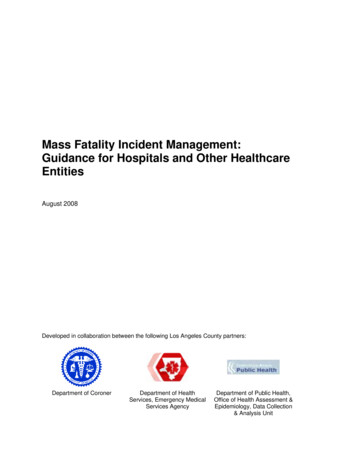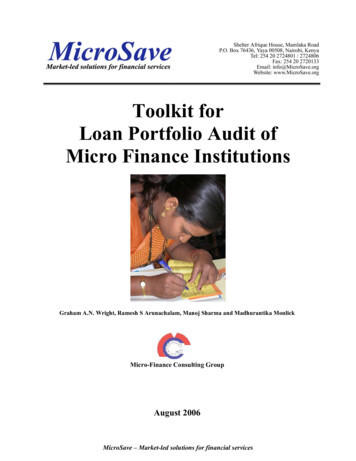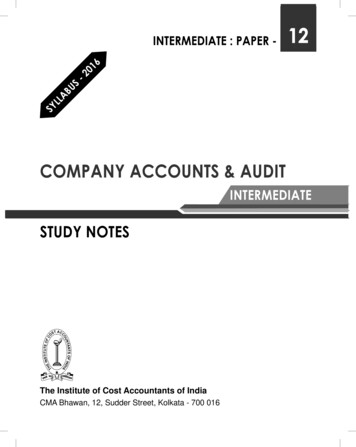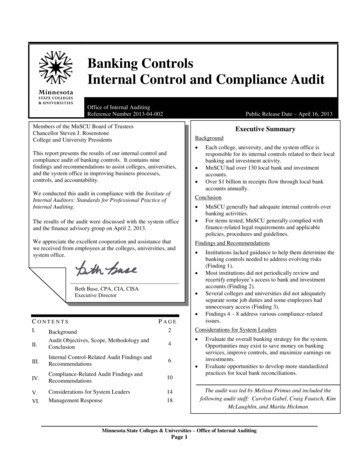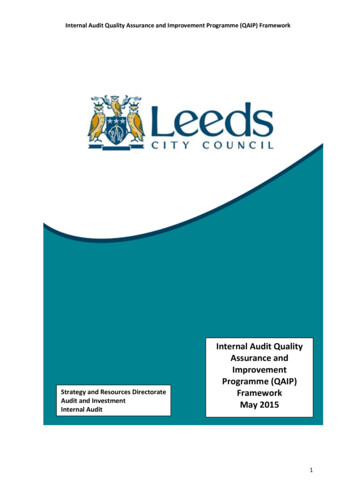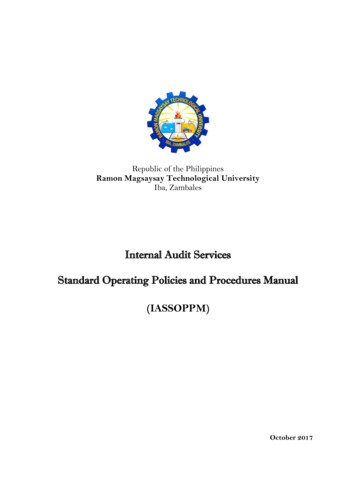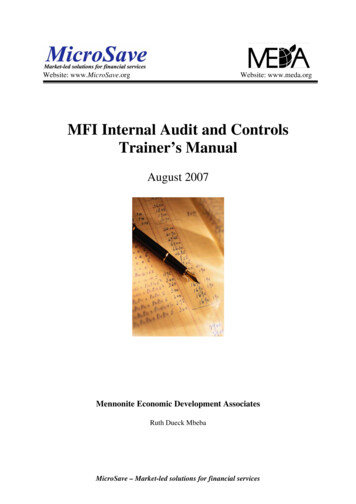
Transcription
Website: www.MicroSave.orgWebsite: www.meda.orgMFI Internal Audit and ControlsTrainer’s ManualAugust 2007Mennonite Economic Development AssociatesRuth Dueck MbebaMicroSave – Market-led solutions for financial services
AcknowledgementsMEDA acknowledges the contribution and input of Ruth Dueck Mbeba, Joyce Lehman, L.B.Prakash, Praveesh Kunam, Madhurantika Moulick and Jasper Vet in writing and development ofthe overall toolkit. Special thanks to Graham A.N. Wright for support and contributions to thedevelopment of the materials. Much of the content and learning is based on industry bestpractices and on MEDA’s work in microfinance over the past years.Many thanks to the helpful input and support from MEDA staff in making this effort possible.A learning toolkit is never “final” as new techniques, tools and resources become available andare shared with one another. Participant feedback and comments will assist to continuallyimprove this toolkit and its resources.MicroSave – Market-led solutions for financial services
MFI Internal Audit and Controls Trainer’s Manualpage iTable of Contents1.SETTING THE CONTEXT: RISK AND RISK MANAGEMENT . 1Session Overview. 1What are the Key Risks in Microfinance? . 3What are the Key Issues of Operational Risks? . 6What are the Key Issues of Managing Operational Risks?. 7Risk Management: Whose Job is it? . 92.OVERVIEW OF INTERNAL CONTROL SYSTEMS . 11Session Overview. 11What do we mean by “Internal Controls?” . 12a.Control Environment . 14b.Risk Assessment . 14c.The Control Activities: Systems, Policies and Procedures . 19d.Information and Communications . 19e.Monitoring. 20What are the Key Challenges for MFIs? . 243.PREVENTIVE CONTROL – HUMAN RESOURCES. 27Session Overview. 27What are the Factors Contributing to Commission of Fraud by Employees? . 29How do we Limit Opportunities? Effective Staff Motivation . 31Model for Sustainable Capacity Building . 384.PREVENTIVE CONTROL – POLICIES AND PROCEDURES . 41Session Overview. 41Accounting Controls . 43Segregation of Duties . 46Independent Checks and Verification . 46Procedures for Cash Receipts . 47Cash Receipts. 47MicroSave – Market-led solutions for financial services
MFI Internal Audit and Controls Trainer’s Manualpage iiProcedures for Cash Disbursements . 48Bank Reconciliations. 49Cash Reconciliations . 50Portfolio Reconciliations – The General Ledger and the Portfolio Tracking System (MIS). 51Document Controls . 515.PREVENTIVE CONTROL – INFORMATION SYSTEMS . 53Session Overview. 53Risks Associated with Lack of Information. 54Managing MFI Information. 54Loan Portfolio Information . 556.ROLE OF THE INTERNAL AUDIT. 61Session Overview. 61What is an Internal Audit?. 62Role of the Internal Audit in the Internal Control System. 62Role of the Audit in the Risk Management Feedback Loop. 63Creating the Internal Audit Team. 63Reporting Function of the Internal Audit. 647.IMPLEMENTING THE INTERNAL AUDIT FUNCTION. 67Session Overview. 67Planning the Internal Audit . 68Professionalism and Conduct. 73Reporting Audit Findings. 73Writing the Internal Audit Report and Making Recommendations . 74Follow up Previous Reports . 76Where Do We Go From Here?. 77Resource Bibliography. 79MicroSave – Market-led solutions for financial services
MFI Internal Audit and Controls Trainer’s Manualpage iiiFiguresFigure 1.1 - External and Internal Risks of HIV/AIDS to an MFI. 5Figure 1.2 - The Role of Internal Controls and Internal Audits in Operating Risk Management. 8Figure 1.3 - Risk Management: Whose Job is it? . 10Figure 2.1 - COSO Internal Control Framework . 13Figure 2.2 - The Risk Management Feedback Loop. 15Figure 2.3 - The Cycle Approach. 16Figure 2.4 - Illustration of Assessing Risk Events, Drivers and Strategies . 18Figure 2.5 - Steps to Evaluate Internal Controls . 22Figure 3.1 - The Fraud Triangle. 29Figure 3.2 - Maslow’s Hierarchy of Human Needs . 31Figure 3.3 - MFI Training Opportunities . 34Figure 3.4 - Model for Sustainable Capacity Building . 39Figure 4.1 - MFI Financial Management Information Systems. 44Figure 5.1 - Areas of Risk in Loan Information. 59Figure 6.1 - Differences Between Internal and External Auditors. 62Figure 6.2 – Sample Organisational Chart. 65List of HandoutsSection 1: Setting the Context: Risk and Risk Management1.1 Workshop AgendaSection 2: Overview of Internal Control Systems2.1 Risk Assessment Tool2.2 Internal Control Questionnaire2.3 Internal Control Diagnostic – TemplateSection 3: Preventive Control – Human Resources3.1 Sample Employee Code of ConductSection 4: Preventive Control – Policies and Procedures4.1 Sample Bank Reconciliation Format4.2 Sample Cash Count and Verification4.3 Sample Internal Control Checklist4.4 Sample Reconciliation Problems and TipsSection 6: Role of the Internal Audit6.1 Sample Internal Auditor Job DescriptionSection 7: Implementing the Internal Audit Function7.1 Sample Internal Audit Annual Work Plan7.2 Internal Audit Checklist – Cash7.3 Internal Audit Checklist – Loan7.4 Internal Audit Checklist – Financial Reports7.5 Internal Audit Checklist – Savings7.6 Internal Audit Checklist – Human Resources7.7 Internal Audit Checklist – Fixed Assets7.8 Internal Audit Checklist – Self Help Groups7.9 MicroSave Debriefing Note #577.10 Games that MFI Staff Play7.11 Sample Internal Audit Report Format7.12 Sample Loan Portfolio Audit Report7.13 Sample Internal Audit Report (Branch)7.14 Sample Internal Audit Report (Self Help Group)MicroSave – Market-led solutions for financial services
MFI Internal Audit and Controls Trainer’s Manual7.15 Management Response to Internal Audit Report7.16 Internal Audit Follow-up ToolList of ExercisesSection 1: Setting the Context: Risk and Risk ManagementSection 2: Overview of Internal Control Systems2.1 Follow the Money (Part I and II)2.2 Risk Assessment Exercise2.3 Internal Control Diagnostic Exercise2.4 Policy and Procedure Compliance and Incident WorksheetSection 3: Preventive Control – Human Resources3.1 Human Resource Policy DiscussionSection 4: Preventive Control – Policies and Procedures4.1 Policy and Procedure Worksheet4.2 Segregation of Duties - Distance Management4.3 Segregation of Duties - Loan Officers Handling Cash4.4 Segregation of Duties - Branch Personnel Problem4.5 Fraud Cases – Ineffective Policies and ProceduresSection 5: Preventive Control – Human Resource Policies5.1 Case – Assessing Preventive ControlsSection 6: Role of the Internal Audit6.1 Internal Audit Group DiscussionSection 7: Implementing the Internal Audit Function7.1 Internal Audit Reporting and Role Play7.2 Investigative Case Studies7.3 MFI Internal Audit Action PlanningMicroSave – Market-led solutions for financial servicespage iv
Setting the Context: Risk andRisk ManagementMennonite EconomicDevelopment AssociatesMicroSave – Market-led solutions for financial services
MicroSave – Market-led solutions for financial services
MFI Internal Audit and Controls Trainer’s Manual1.Section 1 - 1Setting the Context: Risk and Risk ManagementSession OverviewObjectives: Understand risk and risk management within the internal control context Recognize key risks in microfinance Appreciate everyone’s role in the risk management process!Time:1 hourMethods:Lecture, small group discussion and large group discussionMaterials:Flipcharts and pensSlide Show: Electronic PowerPoint presentations: Section 1: hard copy of the PowerPointpresentations and trainer’s notes.1.Risk and Risk ManagementTime: 15 minutes (lecture/discussion)Exercise: noneSlides: 3Handouts: none2.Key Operating Microfinance RisksTime: 20 minutes (lecture/large group brainstorming and discussion)Exercises: brainstorming discussionSlides: 6Handouts: none3.Risk Management: Whose Job is it?Time: 25 minutes (lecture/small group discussion)Exercise: Table group discussionSlides: 4Handouts: noneProcedure1.Risk and Risk ManagementTime: 15 minutes (lecture/discussion)Exercise: noneSlides: 3Handouts: noneMicroSave – Market-led solutions for financial services
MFI Internal Audit and Controls Trainer’s ManualSection 1 - 2The Big PictureMicrofinance institutions exist to fulfill a dual mission – financial sustainability andpositive social impact on the urban and rural poor in urban of the communities thatthey serve. However, too many MFIs are pre-occupied with expansion, out-smartingtheir competition, or reducing their operational costs to take time to look at riskmanagement in their institutions. Others operate without proper systems that helpreduce exposure to risk.The underlying premise of both risk management and effective internal control is that the business –in our case – the MFI, is on a path towards growth, profitability and sustainability, that itactually achieves its mission, and minimizes the risk of loss or failure in the process ofconducting business.To fulfill their mission, MFI risks must be managed! Risk management is key to control thelikelihood and severity of an adverse event.The primary purpose of this toolkit is to look at risk, risk management and internal controls froman operational perspective in the MFI. It provides practical ways for MFIs to approach andimplement effective internal control systems and internal audit functions within their institutions –whether large or small.Risk is the potential that current and future events, expected or unanticipated may have an adverseor harmful impact on the institution’s capital, earnings or achievement of its objectives.Risk management is the process of balancing risk-taking and capital against a well-designedcontrol environment. Managing risks includes identifying, prioritizing and selecting responses torisk. Managing risks effectively reduces the likelihood that a loss will occur and minimizes the scaleof the loss should it occur. Risk management includes both the prevention of potential problems,the early detection of actual problems when they occur, and the correction of the policies andprocedures that permitted the occurrence.Simply put, both the function and activities of “internal audits” and “internal controls” aremitigation strategies for operating risks in MFIs. Internal controls are systems and procedures thatseek to prevent problems and institutional loss. The internal audit function may meet externalregulatory requirements for MFIs. More than that, it is a management tool to monitor theimplementation of internal controls. Internal audits seek to detect problems before they becomelarge and destructive, and they provide assurance and communication to management that itssystems are in place, are functioning and are building the MFI’s capacity to deliver its products andservices sustainably to the community.Risk management is an on-going process because internal and external vulnerabilities keepchanging.A June 2003 publication by the Institute of Internal Auditors wrote that “ .risk and control arevirtually inseparable – like two sides of a coin – meaning that risks first must be identified andassessed; then managed and mitigated by the implementation of a strong system of internalcontrol.” 11Tone at the Top Issue 18, June 2003 pg 2.MicroSave – Market-led solutions for financial services
MFI Internal Audit and Controls Trainer’s ManualSection 1 - 3In today’s business world, risk management takes a comprehensive perspective of risk, risk toleranceand risk management throughout the organisation. It looks at the role of Board governance andmanagement in leading the risk management process, and in setting the tone forstrong internal control systems. 2 The leading internal control model widely adaptedand implemented throughout businesses in the world is summarized in ExecutiveSummary of Internal Control – Integrated Framework 3 . The framework is widelyused as a standard by which to measure and evaluate internal control systems.The traditional view of internal audits has also shifted in recent years from a focus onfinancial transactions and past events, to a pro-active risk-based approach that notonly looks at compliance to policy and procedure, but the effectiveness of riskidentification and assessment, and management’s risk mitigation strategy,implementation and monitoring of risks.This toolkit is built on the key concepts of risk management and internal control from thesecommonly accepted frameworks and from the MicroSave “Institutional and Product DevelopmentRisk Management Toolkit” (Pkholz, 2005). It also references resources and samples fromMicroSave’s “Toolkit for Process Mapping for MFIs” (Champagne 2006) and the “Toolkit for LoanPortfolio Audit of Micro Finance Institutions” (Wright 2006).Is risk management important to MFIs? Of course it is! It is critical for bothgrowth and sustainability. But it is up to you and your MFI to address the issues.Ignore at your own risk!Procedure2.Key Operating Microfinance RisksTime: 20 minutes (20 minutes for lecture/discussion)Exercises: brainstorming discussionSlides: 6Handouts: noneWhat are the Key Risks in Microfinance?All MFIs are exposed to a great number of risks, both internal and external, that threaten effectiveservices to clients, financial stability, and future sustainability. As MFIs grow and become morecomplex, the need for periodic reviews of risk management systems becomes greater. The key risksfor microfinance are often categorized into the following main areas. The management and Board ofyour microfinance institution should consider each risk as a point of vulnerability. It is yourresponsibility to assess the institution’s level of exposure, to prioritize areas of greatest vulnerability,and to ensure that proper controls are in place to minimize your MFI’s exposure.Internal RisksInstitutional Risks:2The Enterprise Risk Management Framework Executive Summary is available at www.coso.org. It wasproduced by the Commission Committee of Sponsoring Organisations of the Treadway Commission (COSO).COSO is comprised of the American Institute of Certified Public Accountants, the American AccountingAssociation, Financial Executives International, The Institute of Internal Auditors, and the Institute ofManagement Accountants.3The Internal Control – Integrated Framework Executive Summary is available at www.coso.orgMicroSave – Market-led solutions for financial services
MFI Internal Audit and Controls Trainer’s ManualSection 1 - 4Microfinance success is defined as an independent organisation providing financial services to largenumbers of low-income persons over the long-term. An assessment of risks against this definitionresults in three categories of institutional risk. Social mission risk – the provision of appropriate financial services to the intended clienteleCommercial mission risk – to manage the organisation as a business to allow it to exist forthe long termDependency risk – continuing need for strategic, financial, and operationalsupport from an external organisationOperational Risks:Operational risks are the vulnerabilities that your MFI faces in its daily operations, including concernsover portfolio quality, fraud and theft, all of which can erode the institution’s capital and undermineits financial position. Credit risk – lending money and not getting it backFraud risk – intentional deception for personal gain illegal or irregular meansError risk – unintentional errors that create unreliable information and reports, or the loss ofassetsSecurity risk – risk of theft or harm to property or personDiscussion: What are common MFI Risks you face?10 minutesTape up 2 flipchart pages: one titled “Internal”; one titled “External” Ask participants in largegroup to suggest risks – both internal and external that their MFI faces. Potential answers mightinclude:InternalExternalDelinquency and defaultRapid growth stressesFraudLack of qualified staffLack of fundingLack of regulatory environmentCompetitionDroughtFloodsEconomics – devaluation, trade tariffsLogistics, infrastructureFinancial Management Risks: Asset and liability risk – management of interest rate, liquidity, and foreign exchange. Theserisks increase and become more complex as the MFI grows, and broadens its range offinancial services to include savings.Inefficiency risk – management of costs per unit of output, affected by both cost controls andlevel of outreachSystem integrity risk – the integrity of the information systems, whether computerized ormanualMicroSave – Market-led solutions for financial services
MFI Internal Audit and Controls Trainer’s ManualSection 1 - 5External RisksAlthough you may have less control over them, MFI managers and Board directors must also assessthe external risks to which they are exposed. Your institution can have relatively strong managementand staff, and adequate systems and controls, but still experience major problems due to theenvironment in which it operates. It is important that these risks are recognized as challenges to beaddressed rather than excuses for poor performance.Regulatory risk – awareness of regulations in banking, labour laws, contract enforcement,and other policies that affect MFIs. Some Central Banks prohibit the collection, mobilizationand use of client savings unless the MFI is registered and licensed to do so. In India, some ofthe partnership loans offered by a large bank to several MFIs were not renewed, severelyresulted in reduced portfolio growth.Competition risk – familiarity with the services of others to position, price, and sell yourservices. Competition for staff is also a huge risk. A large Indian MFI wanting to expand itsoperations, recently recruited 24 out of 36 field staff of a much smaller MFI who was alreadyworking in the same region.Demographic risk – assessing characteristics of the target market. This could look at specialsocial issues, including health, aging, and migration. The HIV/AIDS pandemic is a threat toproductive middle-aged people, posing risks to the MFI’s targeted market and their staff. SeeFigure 1.1 for further elaboration and illustration of how HIV/AIDS risks have both internaland external effects.Physical environment risk – natural disasters, physical infrastructure. Some rural areas (e.g.Bihar in India) may be prone to floods nearly every year. Droughts will also affect the ruralpoor who are dependent on agriculture or agri-businesses; these natural disasters will not onlyaffect clients and their businesses, but the MFIs that serve them.Macroeconomic risk – currency devaluation and inflation and the effect on both theinstitution and the clients. A regular interest rate increase of bank loans to MFIs will reducethe margins available to MFIs and force them to cut operating costs. The market or regulatoryenvironment may be too competitive to increase rates, leaving them little choice to dootherwise.Political/Governmental risk – political instability, civil unrestReputation risk – An MFI’s image amongst clients in the community it serves is critical tostrong repayment and repeat business. Image and reputation in the community does not onlycome from actual and factual information about the MFI. It is about client perceptions and thesatisfaction they feel about the institution, about how they feel they are treated, and whetherthey value the services provided.Figure 1.1 - External and Internal Risks of HIV/AIDS to an MFIRisk Due to HIV/AIDSMFIs that are operating in areas with high HIV/AIDS prevalence rates will face additional risks as there is astrong likelihood that a number of their clients and staff will be either infected or affected by HIV/AIDS. Thishas widespread effects on the local, national and regional economies, impacting MFIs, their staff, their clientsand ultimately their financial performance and operational sustainability.The HIV/AIDS pandemic poses both an external and internal risk to a microfinance institution:MicroSave – Market-led solutions for financial services
MFI Internal Audit and Controls Trainer’s ManualSection 1 - 6External: First of all, the local economy may be affected in terms of market potential and business activity.Individuals and households will have less disposable income for business and consumption investment asmore resources are spent on medical expenses and child care. There are fewer economically active people that are able to contribute to the livelihood of the household orthe local economy. When family members are unable to generate enough income through business, their dependents areusually put under the responsibility of other family members who are able to care for them. This puts aconsiderable strain on the households that agree to take in these dependants and can lead to a down turn inthe local economy. The increase in HIV/AIDS related orphans also presents long term challenges to the MFI as a youngergeneration that has received little skills and business training seeks credit to establish businesses. In the communities with a high HIV/AIDS prevalence, business growth and capitalization becomes moreand more limited, threatening the MFIs long term sustainability and portfolio potential.Internal:The impact of HIV/AIDS on clients presents considerable internal risks to the MFI. These internal risks aregreatly influenced by the external risks explained above. MFIs may find their portfolio negatively affected bythe following factors: Client drop-out: Clients that are over-burdened financially may wish to withdraw their savings and leavethe institution, causing a reduction in the MFI’s client base.Sluggish growth: MFIs may find it difficult to meet their growth targets in regions that are severelyaffected by HIV/AIDS as the economy slows down and the rate of new client intake diminishes.Delinquency: Clients that are infected or affected by HIV/AIDS may find it increasingly difficult to meettheir loan repayment deadlines. An increase in delinquency translates to poor portfolio quality, andultimately sustainability.Client absenteeism from group meetingsHigh staff turnover increases recruitment and training costs, triggers a decline in morale, and leads to a lossof institutional and corporate “memory” of the MFI.Staff absenteeism due to illness or extended leave will affect the MFI’s ability to work efficiently as ateam.Decline in staff productivity due to illness, threatening competitive advantageWhat are the Key Issues of Operational Risks?This toolkit focuses on the key issues of operating risk, and how you as MFI managers, InternalAuditors and finance managers can develop systems and procedures to prevent, detect, and correctpotential problems. Operational risks are the vulnerabilities that your MFI faces in its dailyoperations, including concerns over portfolio quality, fraud and theft, staff capacity and development,and integrity of data and reports, all of which can erode your institution’s capital and undermine itsfinancial position or its growth projections. The following four items are usually considered whenlooking at operational risks Credit risk – refers lending money and not getting it back. There are many aspects of creditrisk. They include the appropriateness of loan products, client demand and preference, andexternal environmental factors (flood, drought, etc.). However, credit risk also looks atwhether credit policies and procedures are correctly followed and administered by staff andwhether credit transactions are properly recorded in your MFI’s loan tracking system andcorrectly summarized and presented in the financial and portfolio reports. MicroSave’s“Toolkit for Loan Portfolio Audit of Micro Finance Institutions” (Wright, 2006) givesextensive and helpful tools and approaches for these key aspects of credit risks and should bereferred to.MicroSave – Market-led solutions for financial services
MFI Internal Audit and Controls Trainer’s ManualSection 1 - 7 Fraud risk – intentional or deliberate deception for unfair or unlawful personal gain. Theseare intentional actions, manipulation of data or documents, or the abuse of office, policies,procedures, or documents of your MFI’s property for the purpose of personal gain. Stronginternal control systems limit the opportunities and possibilities for fraudulent activity. Error risk – unintentional errors due to lack of training and c
4.4 Segregation of Duties - Branch Personnel Problem . 4.5 Fraud Cases - Ineffective Policies and Procedures . Section 5: Preventive Control - Human Resource Policies . 5.1 Case - Assessing Preventive Controls . Section 6: Role of the Internal Audit . 6.1 Internal Audit Group Discussion . Section 7: Implementing the Internal Audit Function
